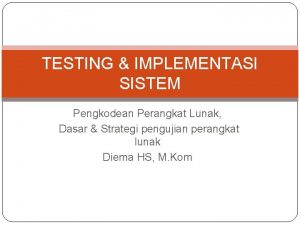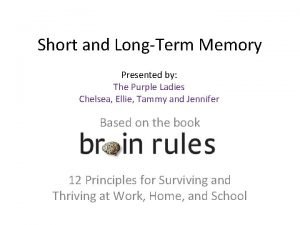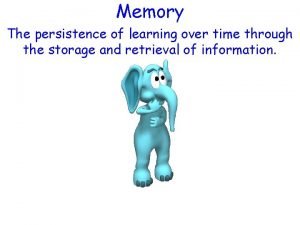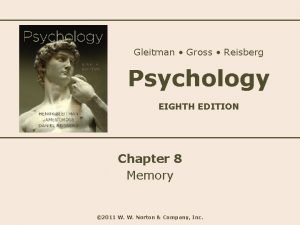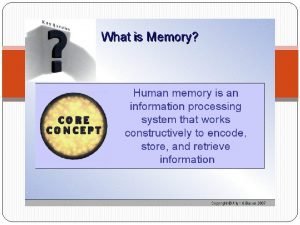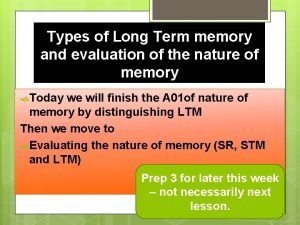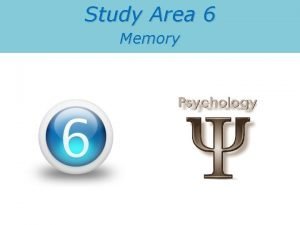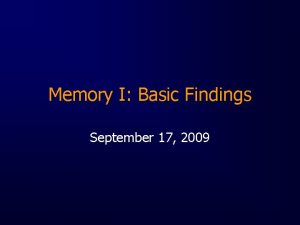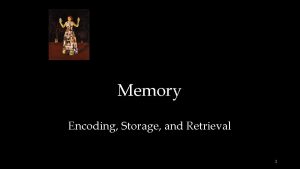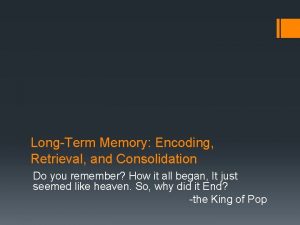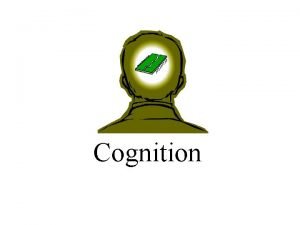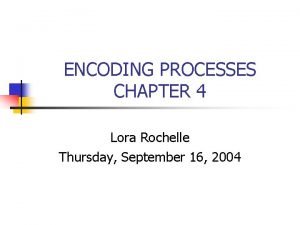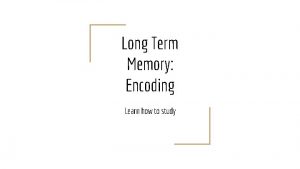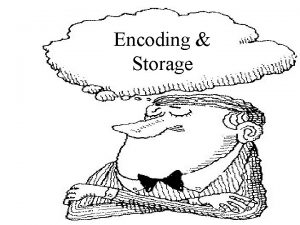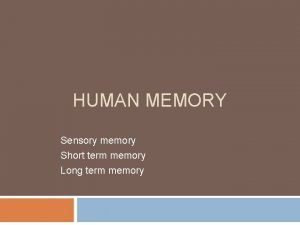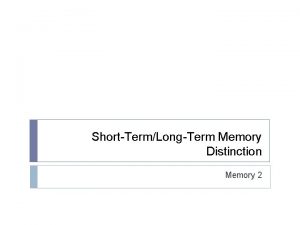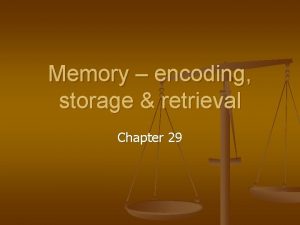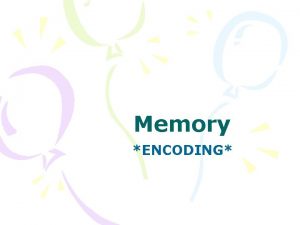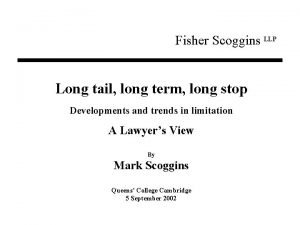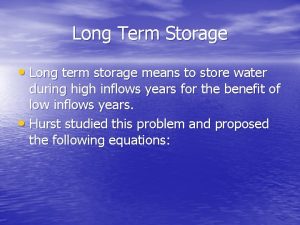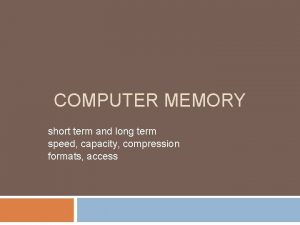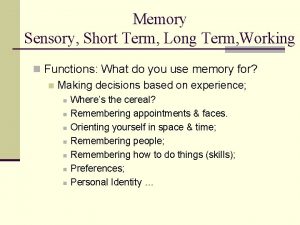Long Term Memory Encoding Learn how to study
























- Slides: 24

Long Term Memory: Encoding Learn how to study

Information Processing Model The information processing modelposits that long-term memory is a system that encodes, stores, and retrieves information (like a computer, again). The way information is encoded critically influences later access to that information. A number of factors, influence encoding. These factors include level of processing (shallow or deep) done with an item, timing of practice (massed or spaced), how a person organizes information, a person’s reference to the self during learning, distinctiveness of an item, and testing during learning.


Levels of Processing The levels-of-processing framework posits that information is processed differently depending upon the instructions and the task and can vary from relatively shallow processing to relatively deep processing. The best retention occurs when processing is elaborative (deep). This concept was first introduced in 1972 and has been replicated in dozens of experiments.

Shallow Processing Shallow processingor maintenance rehearsal focuses on the physical features of an item rather than its meaning. Examples of physical features include color, length, font, or sound of an item. Shallow processing can involve the simple repetition of items. For example, we see pennies every day, but may have difficulty recalling the information on the front or back of a penny. Simply repeating an item over and over again for a test will not commit that item to memory for a long period of time.

How many times seeing something does it take to remember something? 1 time? 10 times? 100 times? Maybe 1000 times?

Let’s look at something very familiar. . .

Which layout is the correct one?

The chance of pointing out the right penny for anyone is about ⅙, or completely random. Although you have likely seen pennies more than 1000 times, you do not remember them because you do not encode them in a meaningful way. It is not the amount of time spent studying an item, but rather the way that time is spent that is important.

Deep Processing Deep processing or elaborative rehearsal focuses on the meaning of an item and involves forming associations between old and new information, with an effort on making elaborate connections with existing knowledge. Examples include processing that focuses on the pleasantness of an item, the definition of an item, and the item’s relationship to other items. When learning new vocabulary, it is best to associate the new item, a vocabulary word, with something you already know well. In preparing for a test, relating course material to information you already know or to something personal in your own life (self-referent) will enhance its retrieval. Recent studies have shown that relating it to your survival also helps.

Let’s learn to study. . .

Timing of Practice Massed practice 1. Massed practice occurs when an individual attempts to learn material all in one setting, with practice crammed into one or two long sessions. 2. Massed practice is not as effective as spaced or distributed practice for long -term retention.

Spaced Practice 1. Spaced practice, also referred to as distributed practice, involves repeated practice of multiple sessions that are spaced out in time. 2. Spaced practice is far more effective for long-term retention. 3. Baddeley and colleagues (1978) demonstrated that post office workers who practiced typing for an hour each day showed better retention than those who practiced typing for the same total amount of time, but instead massed their practice (i. e. , practiced 2 hours a day)

Study Results Scientists found that spaced practice (studying and then waiting a while and studying again) almost always improved memory relative to massed practice (studying and then studying again right away), even though the participants in both the spaced- and massed-practice conditions spent the exact same amount of time studying. For example, with a retention interval of 10 weeks (i. e. , memory was tested 70 days after the last study period), the spaced practice group remembered 111% more than the massed practice group.

Study Tip! When students are studying, they should be sure to space study sessions over time. If a student plans to study 10 hours for a test, devoting 1 hour each day for 10 days to studying or 2 hours a day for 5 days would be effective. Studying 5 hours each day for the 2 days before the test would not be nearly as effective. (Studying for 10 hours the day before is basically useless)


Self-Referent Coding When people organize material around their own lives and experiences, they can elaborate on material easily, and they always have access to the cues (the cues are salient to the individual who created them). For example, if you are learning state or country capitals, relating them to your own travels and experience can improve memory. If you associate Michigan with your grandfather who loves Lance crackers, you may find it easier to remember that the capital of Michigan is Lansing. Or if you associate the United Kingdom with your friend Landon, you could remember the capital of the United Kingdom is London.

Distinctiveness Items that are unique or distinct from others are often remembered best. When an item is naturally distinctive, as is a black swan in a lake filled with white swans, it will be remembered better than the other items that are similar to each other. This is known as the von Restorff effect. Study Tip: You can work to make an item distinct by elaborating on it and providing great detail about it, and the benefit will be similar.


Organization Organizing information also facilitates memory. If someone has a list of items that includes clothing, sporting equipment, food, and travel destinations all mixed together, organizing those items by category will improve recall. The category heading can be used to prompt recall, and relating the items within a category to each other will allow them to serve as cues for each other. Study Tip: If you work to impose an organization on course material that structure will help guide retrieval during tests.

Subjective Organization For material that does not have an obvious structure, imposing some personal organizational strategy or structure on the material can enhance retention. Subjective organization involves developing a personal way to categorize and recall information.

Using Labels Let’s do an experiment. . .

The benefits of testing Taking a memory test not only assesses what a person knows, but can also enhance later retention. This phenomenon is known as the testing effect or test-enhanced learning. Recent experiments demonstrate that people who study and then are tested on material retain that information more effectively over long durations relative to people who study and then study some more (even though both groups spend the same amount of time with the material).

Study Tip! When you study, don’t simply reread your book or even focus on your highlights. You should quiz yourself on the material regularly, so you have a sense of what you know and don’t know and practice and strengthen the connections among associated information in your brain.
 Long term memory vs short term memory
Long term memory vs short term memory Hardware encoding or software encoding
Hardware encoding or software encoding Long term memory example
Long term memory example The persistence of learning over time
The persistence of learning over time Long term memory chart
Long term memory chart Example of encoding failure
Example of encoding failure Jacobs 1887 digit span
Jacobs 1887 digit span What part of the brain stores long term memory
What part of the brain stores long term memory Declarative memory
Declarative memory Memory encoding vs consolidation
Memory encoding vs consolidation Memory encoding techniques
Memory encoding techniques Memory encoding vs consolidation
Memory encoding vs consolidation Memory encoding
Memory encoding Process of memory encoding
Process of memory encoding Long term plan and short term plan
Long term plan and short term plan Short term human resource planning
Short term human resource planning Difference between long term and short term liabilities
Difference between long term and short term liabilities Long-term liabilities examples
Long-term liabilities examples Long-term goals examples
Long-term goals examples Long term and short term financial planning
Long term and short term financial planning Short short short long long long short short short
Short short short long long long short short short Running running running
Running running running Kinesthetic learners definition
Kinesthetic learners definition The more you study the more you learn
The more you study the more you learn Semantic prototype
Semantic prototype

